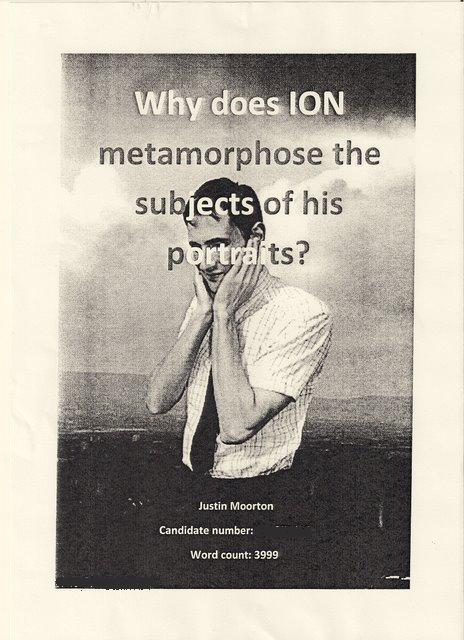
"It is always most flattering and rewarding when one's work appeals to and inspires a younger generation." ION
"Why does ION metamorphose the subjects of his portraits?"
The following conversation appeared in 2009 in Justin Moorton's four thousand word extended essay about "Work on Portraits I" which received a grade A.
JM: For how long have you been interested in photography?
ION: Since forever. I initially had a interest in cameras themselves. I remember my first camera which I found in 1986 on a trip to Rome. Of course I also later went on to study photography.
JM: Is there a general theme or message that can be applied to all of your work?
ION: Yes I think so. I have come to realize that all of my portraits are in some way a reflection of myself, and in this way aspects of my personality come through in my work. I believe this is the fundamental aspect that ties my work together.
JM: Are you influenced by Athens as a City or by the Greek culture in general?
ION: I am influenced by life in the city and out of it. It's the interest in the people and their inter-connections, and also their connection to nature. I wouldn't say that I am influenced by Greece specifically.
JM: Would you say there are any artists that have influenced you in your work?
ION: Consciously no. Unconsciously yes, however still not intentionally. I feel that I have subconsciously been influenced by painters such as Raphael Sanzio and Salvador Dali. However what I love most in their work is their attention to texture and surface quality. As far as photographers go Jeanloup Sieff is my all time favourite. I really believe he is the best b/w photographer that history has had to offer; through his landscapes, portraits or even fashion photography he has proven that he is capable of anything. Recently, I have been very much interested in the work of another very talented French photographer, Robert Doisneau.
JM: Would you call yourself an idealist?
ION: Absolutely! It's part of my nature. I think that, adding to what I said before about me coming through in my work, the idealism inevitably also has to show.
JM: Would you relate yourself to surrealist painters or your work to those of the renaissance?
ION: I do not intend to create surrealistic photographs, but realistic ones in a very suggestive way. I try to avoid making my photographs look like paintings, but instead make as many fine changes to the work without losing its photo qualities. There are definitely strong elements in relation to Renaissance art, which I have also noticed myself.
JM: Why do you metamorphose the subjects of your portraits?
ION: It's very abstract. I seldom start a piece of work knowing exactly how it will turn out. I begin with an idea in my mind, but maybe the work takes me somewhere else completely. There is this exchange of energy and ideas. I think that I make the changes to the subjects to produce work that is timeless, along with allowing for personal qualities to find their way into the photographs. However they cannot be interfered with too much, so I usually see how far I can take it before the essential qualities are disturbed.